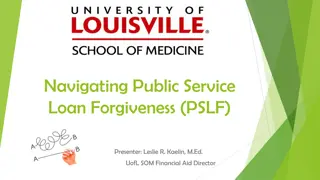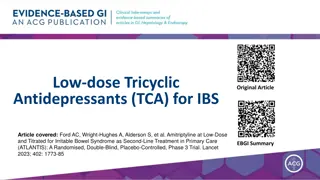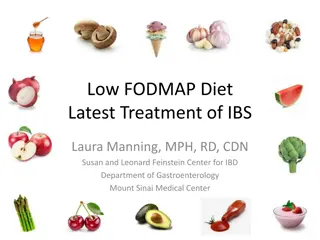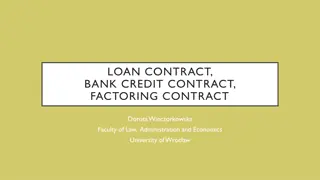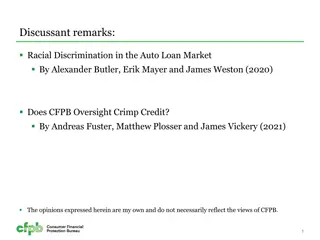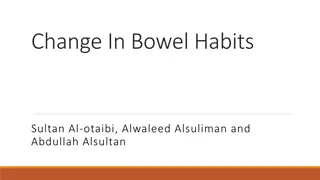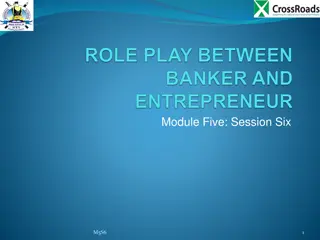IBS Overview: Commercial Loan Risks and Growth
Offering consulting services for commercial lending, IBS has a strong history of underwriting loans and managing portfolios. Explore the challenges in making commercial loans, the benefits of diversification, and the potential for growth in revenue streams.
Download Presentation

Please find below an Image/Link to download the presentation.
The content on the website is provided AS IS for your information and personal use only. It may not be sold, licensed, or shared on other websites without obtaining consent from the author.If you encounter any issues during the download, it is possible that the publisher has removed the file from their server.
You are allowed to download the files provided on this website for personal or commercial use, subject to the condition that they are used lawfully. All files are the property of their respective owners.
The content on the website is provided AS IS for your information and personal use only. It may not be sold, licensed, or shared on other websites without obtaining consent from the author.
E N D
Presentation Transcript
Agenda IBS Overview Why Aren t You Making Commercial Loans Regulatory Environment Risks To Loan Growth/Quality Impact on Lending / Portfolio Board Responsibility Comments & Questions
Services Offered Consulting Commercial Lending Start Up Market Evaluation Hiring Loan Policy Credit Training Sales Training Board Training (Regs) Participation Sales Commercial Loan Underwriting Loan Document Generation Appraisal and Environmental Management Loan Servicing Shared Lender Program
IBS History Formed 2008 & started operations in 2009 in Fort Mill, SC Wholly owned by 7 credit unions in the Carolinas Through 2013 had underwritten $150 million in MBL At YE 2013 was servicing $40 million portfolio Since 2014 have underwritten over 3000 loans totaling over $2.3 billion Credit union portfolios have grown from $40 million to over $820 million in that period Underwrote 422 loans totaling $333 million in 2020 Underwrote 342 loans totaling $323 million in 2021 Underwrote 344 loans totaling $423 million in 2022 At 12-31-22 over $820 million in portfolio underwritten by IBS 99.6% rated Satisfactory or better Of over 1800 loans only 3 not rated Satisfactory or better Past dues range typically under .10%. No net charge off on a loan underwritten by IBS
Why Arent You Making Commercial Loans? Too Risky Nope. But it is MESSY!! Don t have knowledge/expertise/cooperative core That s what CUSOs are for Commercial Lenders are hard to find & too expensive Yes, they are. They are also divas, but there are workarounds to all those issues. Now is just not the right time Why? Lack of liquidity Thanks, FED. Can be fixed but is a challenge Recession is coming Is it? So what if it is. That is not the time to stop lending or to not start lending Core won t support business loan or deposits Can be fixed
Heres What You are Missing Growth and diversification of membership For every new business member, you have a captive audience for several new consumer memberships and ability to cross sell consumer products Growth and diversification of revenue stream For every $10 million in outstanding loans, potential for $350,000+ in net interest income Growth and diversification of a consumer heavy loan portfolio that is more susceptible to economic changes Higher margin on loans Large loan fees Commercial deposits
Regulatory Environment Reg change took effect 1-1-2017 Exams now focusing on regs v. loan policy
Principles Based Regulation Purpose is to give credit unions more flexibility to implement principle-based risk management processes and policies and staff to maintain a comprehensive understanding of the borrower s financial capacity. Credit unions must establish risk tolerances at the relationship and overall portfolio levels to ensure that the risks taken are consistent with prudent standards within the managerial and financial capability of the credit union.
Principle Based Regs Message that examinations will be made based on the law and not on philosophical intent MBLs redefined Loans secured by 1-4 family residential real estate Loans secured by vehicles manufactured for household use MBLs don t count toward cap The cap is the lesser of 1.75 times the actual net worth or 1.75 times the minimum net worth per the risked based standards.
The New Commercial Loan Policy Must address: Types of commercial loans permitted Trade Area Portfolio concentration limits Single borrower limits Qualifications and experience requirements for lending staff Loan approval process Underwriting standards Risk Management processes Annual Reviews, collateral inspections and revalued
NCUA Expectations Underwriting analysis depth and content. Due diligence and risk evaluation requirements of principals of business borrowers. Financial projection analysis when historical results insufficient. No longer need to use industry ratios for real estate financing. Financial statement quality and verification expectations. Collateral perfection and valuation requirements, including LTVs appropriate for specific collateral type.
Revising the MBL Policy Risk Management Process Use of loan covenants Frequency of financial reporting Frequency and depth of ongoing loan review and collateral value monitoring A credit risk rating system, at inception, and through life of loan; tracking migration of risk grades A process to track and report policy exceptions and loan covenants
Post Reg Change NCUA Findings Lack of Board oversight & involvement relative to new rules Inadequate staffing & resources for oversight of 3rdparties Lack of ongoing credit administration of the portfolio ARs, Management reports, Risk Grade migration Inadequate or delinquent ARs Lack of risk assessment & staffing relative to commercial lending & how it fits into the credit union s business or strategic plan Lack of personal guarantees with lack of evidence of risk mitigation
Post 2017 Reg Changes Appraisal Regs Set commercial loan threshold to $1 million Contrary to all other regulators that went to $500,000 CUSO Regs Established CUSOs can make any loans that CUs make Gave NCUA ability additional flexibility to approve permissible CUSO activities and services outside of notice and comment. CECL
Post 2017 Reg Changes Proposed Financial Innovation: Loan participations, eligible obligations, and notes of liquidating credit unions Major impact on 701.21-Loans and lines of credit to members Little to no effect on 701.22 701.23 establishes notes purchased from liquidating FCUs Eligible obligations defined as anything that is not being sold as a participation Widens ability to purchase non member loans Ability to purchase whole or in part Helps with FinTech and other 3rdparty originators Mostly impacting consumer loans Indirect loans/leases Loans made by third parties Dealerships, CUSOS, etc.
Post 2017 Reg Changes 5% cap remains on participation purchases but does not apply to purchases of eligible obligations Definition of indirect loan and lease comes from guidance that has been in use 701.23 addresses Eligible Obligations Comment period ends 2-28-23 Expected to be approved by NCUA board between June and August 2023.
NCUA 2023 Supervisory Priorities Interest Rate & Liquidity Risk Letter to CU 22-CU-09 Market Risk Stress Test on loans & portfolio Key assumptions are reasonable and documented Liquidity Related to IRR volatility Higher rates impacting asset valuation & borrowing capacity
NCUA 2023 Supervisory Priorities Credit Risk CU s credit risk review system in identifying, monitoring and managing credit risk Evaluate how credit risk is changing due to inflation, borrowing costs from higher rates & increased likelihood of economic downturn Review adjustments made to underwriting standards, portfolio monitoring practices and to loan loss reserves Current expected credit loss from CECL implementation Fraud Prevention & Detection
Recent NCUA Letters and Policy Statements Climate Change Financial Risk for Credit Unions Physical Risk Affecting the industry Strategies to prepare for effects of physical risk Impact on Members Financially vulnerable populations Steps needed to continue lending to these populations Transition Risk Risks affecting operations, RE lending, commercial lending and small business lending Steps to minimize transition risk Steps to mitigate transition risk
Recent NCUA Letters and Policy Statements Climate Change Financial Risk for Credit Unions Operations Governance Business Strategies Risk Management Looking for a Climate Policy Identify, measure, monitor, manage, and report climate related financial risks Impact on traditional risk areas: credit, interest rate, liquidity, transition, strategic, reputation, and compliance Risk mitigation strategies Flood risk Reporting
Recent NCUA Letters and Policy Statements Policy Statement on Prudent CRE Loan Accommodations and Workouts FIs that implement prudent CRE loan accommodation and workout arrangements after performing a comprehensive review of the borrower s financial condition will not be subject to criticism for engaging in these efforts, even if these arrangements result in modified loans with weaknesses that result in adverse classification
Recent NCUA Letters and Policy Statements Policy Statement on Prudent CRE Loan Accommodations and Workouts Modified loans to borrowers who have the ability to repay their debts according to reasonable terms will not be subject to adverse classification solely because the value of the underlying collateral has declined to an amount less that is less than the outstanding balance on the loan
Recent NCUA Letters and Policy Statements Policy Statement on Prudent CRE Loan Accommodations and Workouts Short-Term Loan Accommodations Accounting Changes CECL Valuation Adjustments Market Conditions Classification Global Cash Flow Frequency of Updated Financial and Collateral Information Proactive Engagement with Borrowers
Recent NCUA Letters and Policy Statements Policy Statement on Prudent CRE Loan Accommodations and Workouts Loan Workout Programs Renewing or Extending Loans Granting additional credit to improve prospects of overall payment Restructuring the loan with or without concessions Updated and comprehensive financial info on borrower, property and guarantors Current valuations of the collateral Appropriate loan structure (term, amortization, covenants, other requirements Appropriate legal analysis and agreements Global cash flow/debt coverage analysis
Recent NCUA Letters and Policy Statements Policy Statement on Prudent CRE Loan Accommodations and Workouts Loan Workout Policy that establishes Loan terms/amortization to reasonably adjust the workout plan is sustained performance is not demonstrated Management infrastructure to identify, measure, and monitor the volume and complexity of the workout activity Documentation standards to verify borrower s credit worthiness: financial condition, repayment ability, coll values Information systems and controls to identify and track loan performance and risk Processes to ensure regulatory reports are consistent with regulatory requirements Loan collection procedures Adherence to lending limits Collateral administration Ongoing credit risk review function
Its The Economy, Stupid!! No, It s the Pandemic!!! No, It s the Economy Again!!! No, It s the Stupid FED
No, Its the Pandemic/Economy Nationwide shut down Extended in some markets Huge impact on small businesses, home renters/landlords, and certain CRE products (retail, multi family, office, hospitality) Dire predictions for commercial RE Supply Chain problems still occurring 2021 Retail Sales rose 21.4% above its pre-pandemic Feb 2020 peak
No, Its the Economy, again Job quit rates in 2020 and 2021 were unprecedented while unemployment rebounded from the effects of the shutdowns and lay offs Businesses still can t fill open positions Inflation increasing since start of pandemic and was over 6% in 2021, hit a high of 9.1% in Jun 22, declining since then to 7.7% in Oct. Now 12 straight months of decline.
No, Its the stupid FED Fed fund target rate remained low; 0%-.25%, but a rising rate environment was expected with 3-4 .25% bumps in 2022 sand into 2023. Reality is there have been 11 increases since March 2022 raising Fed rate from .25-.50% to 5.25-5.50% thru July 23. Another 25 bps expected in before YE (?) Devastating impact on FI liquidity Erosion of capital FI failures
Headlines & Headwinds As of March 31, 2023, over 170 companies have conducted a total of 55,790 layoffs 10.1 million vacant jobs in April 2023 Yellow Trucking gone. 30,000 jobs lost Hiring numbers have been declining Divided country/government Trade Policy/Trade War Recession? For the last 18 months it s been 6 months away Overheated job market ? Businesses still can t find workers
Headlines & Headwinds Irrational Exuberance/Equity markets Tech, tech, and tech. Oh yeah, and everything else. Growing budget deficits/debt Debt ceiling debate will continue US credit downgraded Global inflation and interest rate increases Sources: Wells Fargo Securities Economic Group, Regions Financial Corp. Economic Group, Wall Street Journal
Headlines & Headwinds Liquidity Issues Households have burned through pandemic savings Investors still have lots of cash-just not in the FIs Inability to house business deposits No commercial loan program in your credit union
So, What Does All This Mean for Commercial Lending? Underwriting Peel the onion all the way to the core Get all the information up front You know what credit needs and what they will ask for Ask questions and get answers Follow proper due diligence practices Trust (?) but verify Loan policy is your bible. Use it like one. Dot the I(s) and cross the T(s). Then do it again. Remember you are the one fronting the $$ needed for the project
So, What Does this Mean for Commercial Lending? Portfolio Management Review portfolio now Annual Reviews Yes, they are meaningful if done right. Don t use it as a check mark on a list. Do you have fully executed docs in file? Are collateral docs in order and liens perfected and protected? Recorded UCCs, recorded mortgages and AOR? Liens on titles? Current insurance with CU as loss payee. Have RE taxes been paid, or was collateral sold in a tax sale and you still don t know? Have you inspected the collateral? Take your attorney to lunch
So, What Does this Mean for Commercial Lending? Above all else, do not stop lending Modify appetite for risk Be more selective about deals Get the rate and fees associated with the risk But stay active in the commercial lending arena
Mark Cox President & CEO P O Box 956 Irmo, SC 29063 Phone: 803-881-2500 mcox@ibscu.com www.ibscu.com






